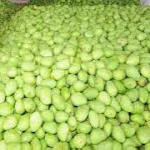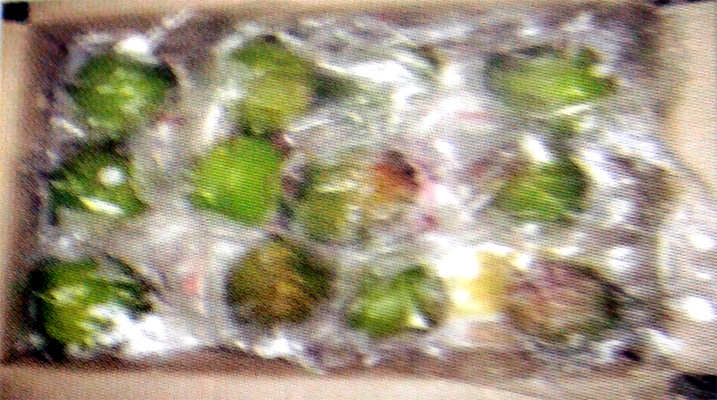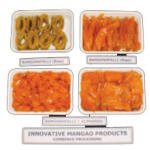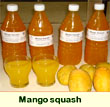Post harvest management
Fruit coatings to extend the storage life
Pectin coating (1%) alone or MA packing of
non-coated fruits in micro-perforated (0.0125%)
cryovac film could alleviate CI and extend the
storage life of Alphonso mangoes upto 4 weeks at 8°C
followed by 1 week (including ripening) under
ambient conditions (27.0-34.3°C). Integration of
both the treatments had no additional beneficial
effect
|
|
|
|
|
 Post
harvest management Post
harvest management |
|
|
|
Modified Atmosphere packaging of Mango (
Alphonso and Banganpalli)
|
 |
Mangoes individulaly packed in micro perforated
PE or PP Films extend the storage life to 1
month at 8 degree C with out chilling injury. |
|
|
|
Innovative mango products
|
|
In an experiment conducted to develop
low sugar osmo-dried ripe mango slices of Alphonso, a
process was standardized using ripe fruits slices and
the final product had 7% less sugars compared to the
normal osmo-dried slices. The final yield of the product
was in the range of 15.3
- 28.2% and moisture content
was 13.26 - 26.25% based on the treatments.
|
 |
Blended RTS beverage from mango :
The beverages will act as natural fruit nutrient
supplier and useful for thirst quenching.
Unit cost : Rs. 1.50 packing of 1 kg. produce.
Mango fruit is an excellent source of Vitamin-A. Both
mango and mango products are popular in India and are
also in demand in many foreign countries |
 |
Long term preservation of raw mango slices in
brine for use in pickling: Preservation of
fruits and Vegetables by fermentation and pickling is
one of the oldest methods practiced throughout the
world. In India, pickling is done on a commercial scale
and has become one of the major food industries in
recent years. Among various types of pickles produced
mango pickles are in great demand both for domestic and
international market.
Input: Seeds of the variety (i) Raw
mango (ii) Salt (iii) Storage tanks, drums (iv)
Permitted additives and Preservatives.
Specific benefits: The feasibility of
process for commercial adoption has been successfully
tested in pickle industry. A high economic return is
envisaged by the adoption of this process which
significantly reduces the microbiological spoilage,
eliminates the problem of softening resulting in
machines and ensures good retention of colour, flavour
and texture in finished pickles. The potential benefit
of this process can be realized in the reduction of
spoilage during storage of slices and also in the
production of pickles with uniform quality.
Description: Pickles are generally prepared
from immature or mature unripe mangoes with or without
peeling/destemming, using salt and different spice
formulations to provide a wide range of flavour, taste
and quality. Acidic and fibrous varieties are ideally
suited for pickle production. Raw mangoes required for
pickling are available only during a short period of 3-4
months of cropping season. This necessitates
preservation of these raw mangoes for extended period
for pickle production round the year. Traditionally
mango pieces are stored by dry salting process. This
method involves storing mango pieces over layers of
salt. Changes in colour, texture and microbiological
spoilage are the common problems associated with this
method. To overcome these problems, a brining method of
preservation has been developed at the Indian Institute
of Horticultural Research, Hessaraghatta, Bangalore.
|
Snack food: A
preliminary trial was conducted to develop a snack food
using shredded raw (Totapuri and Banganapalli) and ripe
(Alphonso) mango fruits. The finalized product was a
dry, highly palatable and a storable snack. Further
studies on quality parameters are under progress.
Effect of gradient temperature conditioning storage on
fatty acid unsaturation, reactive oxygen species,
antioxid- ant enzymes and chilling injury in Alphonso
mango.
Matured Alphonso fruits were stored at 5°C with or
without gradient temperature conditioning (20 to 8° C
over duration of 15 days). Visible chilling injury was
completely absent in gradient temperature conditioning
treatment at the end of 30 days of storage. However at
5°C storage, 30% of fruits showed the visible chilling
injury symptoms. Total carotenoids and fatty acid
unsaturation were more and production of reactive oxygen
species was less in gradient temperature stored fruits
compared to direct storage at 5°C. |
|
|